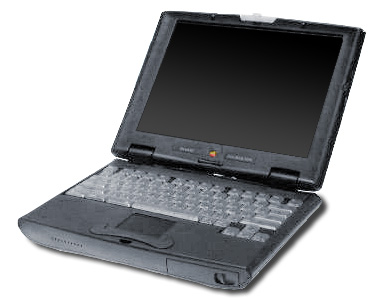- PowerBook 2400c
Mac_specs

Introduced=May 8 1997
MSRP=3500
CPU=PowerPC 603e
CPUspeed=180 or 240 (Japan only) MHz
OS=System 7.6.1
RAM=16MB , expandable to 112 MB
RAMtype=60 nsSO-DIMM
Discontinued=March 14 ,1998 The PowerBook 2400c (codenames: "Comet", "Nautilus") is asubnotebook inApple Computer 'sPowerBook range of Macintosh computers, weighing convert|4.4|lb|kg|lk=on. Manufacturing was contracted toIBM . [cite journal| url = http://www.macaddict.com/issues/1997/8/reviews/powerbook2400c | title = MacAddict reviews: PowerBook 2400c | accessdate = 2006-05-14 | publisher = MacAddict | first = David | last = Reynolds] In a return to thePowerBook 100 form factor, It was introduced in May 1997 as a late replacement for thePowerBook Duo 2300c , which had been the last of the subnotebookPowerBook Duo series. The 2400c was discontinued in March 1998, with no immediate replacement — the model that followed it was the much largerPowerBook G3 Series (known as "Wallstreet"/"Mainstreet"). However, inJapan a 2400c with a 240 MHz CPU (codenamed "Mighty Cat") was offered shortly after the original model's discontinuation, until the end of the year.The 2400c uses the same
PowerPC 603e processor as the preceding Duo 2300c, but at a much higher CPU clock - 180 instead of 100 MHz. However, the 2400 is unable to utilize the DuoDock like the 2300c was, making the lack of an internal removable drive much more noticeable. Like the PowerBook 100 and Duo series before it, it was sold with an external floppy drive. Apple did not offer aCD-ROM drive for it which was otherwise standard for all other PowerBooks. Unlike the Duo, reinstated peripheral ports on the machine most closely matched those of the original 100 and include: ADB, one combined serial printer/modem port, HD-20 floppy port, HD-30 SCSI port, but added a VGA video out, as well as a stereo sound out and in, infrared port, and two PCMCIA card slots. The PCMCIA slots officially accept only 2 Type II or 1 Type III PCMCIA-spec cards, but some users have applied simple motherboard modifications to allow the use of Cardbus expansion cards as well, extending the practical life of this subcompact until a replacement was eventually offered by Apple. The 2400 is built around a 10.4 inchactive matrix color LCD screen, making the computer very compact indeed - it is slightly smaller and lighter, though a bit thicker, than a 12 inchiBook , and the fourth smallest subnotebook behind the 12"PowerBook G4 introduced several years later. Apple's current offering in this category is theMacBook Air .Due to its processor being located on a detachable
daughter card , the PowerBook 2400c saw a small number ofPowerPC G3 processor cards created for it. Companies such as Interware, Vimage, and Newer Technologies offered processor upgrades which would swap out the 603e for a G3 ranging from 240 MHz to 400 MHz. These cards are often highly sought after and can bring large dollar amounts at online auctions.References
* [http://docs.info.apple.com/article.html?artnum=112416 PowerBook 2400c/180] at Apple Computer's AppleSpec
* [http://apple-history.com/?page=gallery&model=2400 PowerBook 2400c] at apple-history.com
* [http://lowendmac.com/pb2/powerbook-2400c.html PowerBook 2400c] at lowendmac.com
* [http://everymac.com/systems/apple/powerbook/stats/mac_powerbook2400c_180.html PowerBook 2400c/180] and [http://everymac.com/systems/apple/powerbook/stats/mac_powerbook2400c_240.html 2400c/240] at EveryMac.comFootnotes
Navbox with columns
name = Navbox with columns/doc
state = uncollapsed
title = Apple Model Navigationcolstyle = text-align:center;background:silver;
colwidth = 25%col1header = Replaced
col2header = Current Model
col3header = Successorcol1 =
PowerBook Duo
col2 =PowerBook 2400c
col3 =MacBook Air PowerBook G4 (12 inch)col1footer = Preceding Family Model
col2footer =May 8 ,1997
col3footer = Following Family Model
Wikimedia Foundation. 2010.
